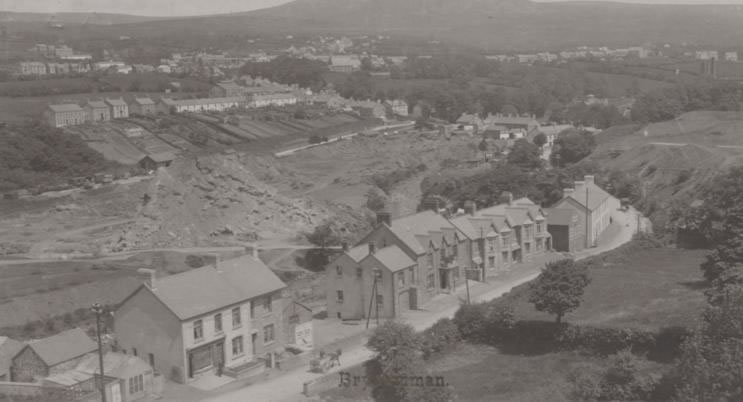Some Captured History of Glanamman and GarnantOther Areas: Brynamman, formerly known as Gwter Fawr
Brynamman: Formerly Gwter Fawr c.1913 The village of Brynamman was once known as "Gwter Fawr". The village earned it's name from the large gutter which was formed in the landscape by early coal production. It is believed that where the Big Vein outcrops on the Southern slope of the River Amman, a technique called "sleisho" (slicing), or "sgwrio" (scouring), was used to access the coal. This entailed the damming of the river upstream of the coal outcrop and the loosening of the soil at the location of the outcrop. When the water was released, the soil was washed away, giving access to the coal. This system is believed to have also been used by the Romans at the Dolaucothi Gold Mines at Pumpsaint. It is not certain when the gutter first came into existance, but it is believed to have been obliterated around 1860. Historian Enoch Rees claimed that some sections were still visible around 1880, but landscaping of the area by British Coal in the late 20th century finally removed the final traces of the gutter. In his book "Hanes Brynamman 1883 & 1896", Enoch Rees stated that the gutter ran from "Gorsgoch Uchaf" on the edge of Caegurwen Common, past the "Castell", past "Pantycelyn", through "Gilfach Pant yr Hala", past the "Croffte", past the "Old Farmers" (Brynamman Hotel), to the river. Circa 1800, there was no village as such, but merely a couple of dozen or so farms situated on either side of the River Amman. Enoch Rees wrote that the first coal mine in the village was worked around 1802 or 1810, by John Jones of Brynbrain (1759-1835). This was situated in the vicinity of the gutter. The formation of the village of Gwter Fawr began with the first row of houses (the "Tai'r Offis"), being built near the gutter and the first of the village's schools was established nearby by Dafydd Williams of Cwmgarw in 1825. Here also, was a cottage where two brothers produced wooden utensils and wollen cloth. The first public house, "Yr Hên Farmers" was built in 1823 at the location where the gutter entered the river. The first philanthropic society in the locality, which became known simply as "Yr Hên Glwb" (The Old Club), was formed here on the 5th of May, 1824. In either 1836 or 1837, on the 25th of August, the Ivorites Society was established here. This society later moved to the New Farmers. A village fair; "Ffair y Gwter" became a regular sight on the Banwen, where it was held twice a year. John Jones (the second son of the John Jones mentioned
above), built a house on land which was part of Bryn Bach Farm. This
was completed in 1838 and was named Brynamman House. It was the first
building in the village to have a slate roof. John Jones (the younger),
was the sponsor of a day school and Sunday school at the village.
He and his father are also accredited with the industrialisation of
Gwter Fawr. In 1840, the New Farmers was built only a few hundred yards from the Old Farmers. It was only the third building in the area with a slate roof. Baptist meetings were held in the club room of the new Farmers Arms, the minister being Mr Edwards; the Baptist minister from Pontardawe. The Baptisms were carried out in the river near the bridge. A Baptist chapel was built in 1870. The New Farmers is now known as Brynamman Rugby Club. In 1864 the Swansea Vale Railway reached the village of Gwter Fawr and the new railway station was constructed near Brynamman House. The name "BRYNAMMAN" was shown in big letters on the station and was also printed on the tickets. In 1866, the post office opened under the name "Brynamman Post Office." By then, the gradual transition of the village name from Gwter Fawr to Brynamman was underway. On the 25th of October 1886, the Great Western Railway Company opened the line from Pantyffynon to Brynamman. This service ended on 18th August 1958. The Old Farmers, was rebuilt in 1894 and was renamed the "Brynamman Hotel". The sign with the new name was put up on the 12th September 1895. A local tourism leaflet tells us that Margaret Rees; a landlady of the Raven Inn, at Garnant, was born at The Farmers Arms and met the author, George Borrow. He wrote a travelogue titled "Wild Wales" and his stay at the Farmers is recorded in the chapter titled "Inn at Gwter Vawr". Much of the above information was taken from "Hanes Brynamman", by Enoch Rees. Other sources include an article written for the Amman Valley Historical Society, entitled, "How a Village Changed it's name - Gwter Fawr - Brynamman", by Ken Evans. |
